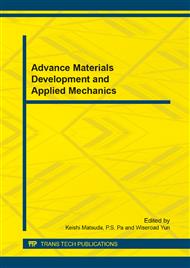[1]
A. Aamodt and E. Plaza, Case-Based Reasoning: Foundational Issues, Methodological Variations, and System Approaches, AI Communications, Vol. 7, No. 1, pp.39-59, (1991).
DOI: 10.3233/aic-1994-7104
Google Scholar
[2]
C.A. Arango, J.R. Martínez, V.Z. Pérez, Master-slave System using Kinect and an Industrial Robot for Teleoperation, Proceedings of 2013 Pan American Health Care Exchanges (PAHCE), pp.1-6, (2013).
DOI: 10.1109/pahce.2013.6568284
Google Scholar
[3]
D.S.O. Correa, D.F. Sciotti, M.G. Prado, D.O. Sales, D.F. Wolf, F.S. Osorio, Mobile Robots Navigation in Indoor Environments Using Kinect Sensor, Proceedings of 2012 Second Brazilian Conference on Critical Embedded Systems, pp.36-41, (2012).
DOI: 10.1109/cbsec.2012.18
Google Scholar
[4]
Z. Dogmus, A. Papantoniou, M. Kilinc, S.A. Yildirim, E. Erdem, V. Patoglu, Rehabilitation Robotics Ontology on the Cloud, Proceedings of 2013 IEEE International Conference on Rehabilitation Robotics, pp.1-6, (2013).
DOI: 10.1109/icorr.2013.6650415
Google Scholar
[5]
H.H. Ku and S.Y. Huang, Design of an Web 2. 0 QoS-based Digital Convergence Service Platform, Proceedings of 9th International Conference on Computing Technology and Information Management, Vol. 4, pp.255-260, (2013).
Google Scholar
[6]
M. Narita, S. Okabe, Y. Kato, Y. Murakwa, K. Okabayashi, S. Kanda, Reliable Cloud-based Robot Services, Proceedings of 39th Annual Conference of the IEEE Industrial Electronics Society, pp.8317-8322, (2013).
DOI: 10.1109/iecon.2013.6700526
Google Scholar
[7]
E. Ruiz, R. Acuna, N. Certad, A. Terrones, M.E. Cabrera, Development of a Control Platform for the Mobile Robot Roomba using ROS and a Kinect Sensor, Proceedings of 2013 Latin American Robotics Symposium and Competition, pp.55-60, (2013).
DOI: 10.1109/lars.2013.57
Google Scholar
[8]
M. Tenorth, A.C. Perzylo, R. Lafrenz, M. Beetz, Representation and Exchange of knowledge about Actions, Objects, and Environments in the RoboEARTH Framework, IEEE Transactions on Automation Science and Engineering, Vol. 10, No. 3, pp.643-651, (2013).
DOI: 10.1109/tase.2013.2244883
Google Scholar
[9]
L. Turnbull and B. Samanta, Cloud Robotics: Formation Control of a Multi Robot System Utilizing Cloud Infrastructure, Proceedings of 2013 IEEE Region 3 Technical, Professional, and Student Conference, pp.1-4, (2013).
DOI: 10.1109/secon.2013.6567422
Google Scholar
[10]
G. Xing, S. Tian, H. Sun, W. Liu, H. Liu, People-following System Design for Mobile Robots Using Kinect Sensor, Proceedings of 2013 25th Chinese Control and Decision Conference, pp.3190-3194, (2013).
DOI: 10.1109/ccdc.2013.6561495
Google Scholar


